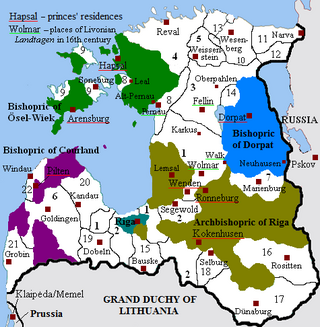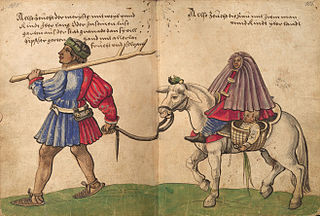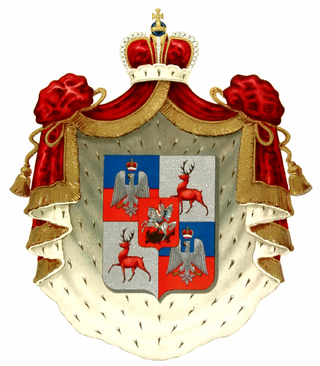
Livonia or in earlier records Livland, is a historical region on the eastern shores of the Baltic Sea. It is named after the Livonians, who lived on the shores of present-day Latvia.

Year 1501 (MDI) was a common year starting on Friday of the Julian calendar.

Ivan III Vasilyevich, also known as Ivan the Great, was Grand Prince of Moscow and Sovereign of all Russia. Ivan served as the co-ruler and regent for his blind father Vasily II from the mid-1450s before he officially ascended the throne in 1462.

The Livonian Order was an autonomous branch of the Teutonic Order, formed in 1237. From 1435 to 1561 it was a member of the Livonian Confederation.

The Livonian War (1558–1583) was fought for control of Old Livonia. The Tsardom of Russia faced a varying coalition of the Dano-Norwegian Realm, the Kingdom of Sweden, and the Union of the Grand Duchy of Lithuania and the Kingdom of Poland.

The Battle of the Vedrosha River was a battle in the course of the Russo-Lithuanian war of 1500–1503 which ended with a decisive Russian victory and proved to be of strategic significance. It was carried out on 14 July 1500, some 50 km to the west of Kaluga, between forces of the Grand Duchy of Lithuania, under command of Prince Konstantin Ostrozhsky and Russian (Muscovite) army under Prince Daniil Shchenya.

Prince Daniil Vasiliyevich Shchenya was a Russian military leader during the reigns of Ivan III and Vasili III.

The Princes Shuisky was a Rurikid family of Boyars descending from Grand Duke Dimitri Konstantinovich of Vladimir-Suzdal and Prince Andrey Yaroslavich, brother to Alexander Nevsky. The surname is derived from the town of Shuya, of which the Shuiskys gained ownership in 1403. From 1606 to 1610, Vasili Shuisky ruled as tsar over Russia during the Time of Troubles.

Woltervon Plettenberg was the Master (Landmeister) of the Livonian Order from 1494 to 1535 and one of the greatest leaders of the Teutonic knights. He was an important early Baltic German.
Severia or Siveria is a historical region in present-day southwest Russia, northern Ukraine, and eastern Belarus. The largest part lies in modern Russia, while the central part of the region is the city Chernihiv in Ukraine.

Pskov, known at various times as the Principality of Pskov or the Pskov Republic, was a medieval state on the south shore of Lake Pskov. Originally a principality and then a part of the Novgorod Republic, Pskov became an independent republic in 1348. Its territory was roughly equivalent to the modern Pskov Oblast of Russia. Its capital city was Pskov.
The Muscovite–Lithuanian Wars were a series of wars between the Grand Duchy of Lithuania, allied with the Kingdom of Poland, and the Grand Duchy of Moscow, which would later become the Tsardom of Russia. After several defeats at the hands of Ivan III and Vasily III, the Lithuanians were increasingly reliant on Polish aid, which eventually became an important factor in the creation of the Polish–Lithuanian Commonwealth. Before the first series of wars in the 15th century, the Grand Duchy of Lithuania controlled vast stretches of Eastern European land, from Kyiv to Mozhaysk, following the collapse of Kievan Rus' after the Mongol invasions. Over the course of the wars, particularly in the 16th century, the Muscovites expanded their domain westwards, taking control of many principalities.
The Pskov Land was a historical region in the north-west of the medieval Russia centred around the city of Pskov. It was a vassal state of various Rus' states and had a measure of independence as Pskov Republic before being annexed by the Grand Duchy of Moscow. It had an important role in the trade and conflicts between Russia and its western neighbours.

Ludza Castle was a medieval castle built in Gothic style located next to a Catholic church, on the site of a former Latgalian wooden castle in the centre Ludza, Latvia, a small town in eastern Latgale. Its main purpose was to be an eastern outpost to control trade routes from Russia. Nowadays the impressive fragments of the castle walls, including a three-floor high fragment, still remain. The ruins are the main tourist attraction in the Ludza District, and is considered a symbol of the town.

The Livonian campaign of Stephen Báthory took place in the final stage of the Livonian War, between 1577 and 1582. Polish-Lithuanian forces led by Stephen Báthory (Batory), King of Poland and Grand Duke of Lithuania, successfully fought against the army of Ivan IV "the Terrible", Tsar of Russia, over the Duchy of Livonia and Polotsk. Russian forces were expelled from Livonia before the campaign was concluded by the Truce of Jam Zapolski.
The Treaty, Truce or Second Peace of Novgorod was concluded in March 1557. It ended the Russo-Swedish War (1554–1557), a series of skirmishes in the Viborg and Oreshek areas resulting from Swedish attempts to keep Livonia, where the Teutonic Order's rule had collapsed, out of the Russian sphere of influence.
The Battle of Ula or Battle of Chashniki was fought during the Livonian War on 26 January 1564 between the Grand Duchy of Lithuania and the Tsardom of Russia on the Ula River north of Chashniki in the Vitebsk Region. The Russian troops, unarmed and moving in a loose formation, were taken by complete surprise and defeated, losing their large wagon train.

Novgorodian Land was one of the largest historical territorial–state formations in Russia, covering its northwest and north. Novgorod Land, centered in Veliky Novgorod, was in the cradle of Kievan Rus' under the rule of the Rurikovich dynasty and one of the most important princely thrones of the era. During the collapse of Kievan Rus' and in subsequent centuries, Novgorod Land developed as the Novgorod Republic: an autonomous state with republican forms of government under the suzerainty of the great princes of Vladimir-Suzdal. During the period of greatest development, it reached north to the White Sea, and in the east it spread beyond the Ural Mountains. It had extensive trade relations within the framework of the Hanseatic League and with the rest of Rus'. Muscovy conquered the Novgorod Republic in 1478, and annexed it in 1578, although Novgorod Land continued to exist as an administrative unit until 1708.

Landmeister in Livland was a high office in the Teutonic Order. The Landmeister administered the Livonia of the Teutonic Order. These lands had fallen to the Teutonic Order in 1237 by the incorporation of the former Livonian Brothers of the Sword. The seat of the Landmeister was castle Wenden. The Landmaster's function in Livonia lasted until 1561, when in aftermath of Livonian War the last Landmeister Gotthard Kettler relinquished the northern parts of the Mastery and in the Union of Vilna secularized the part still left to him and, as the Duchy of Courland and Semigallia, took fief from the Polish king and Grand Duke of Lithuania Sigismund II Augustus. The non-recognition of this act by Pope, Holy Roman Empire and the Grand Master of the Teutonic Order had no factual effect.













